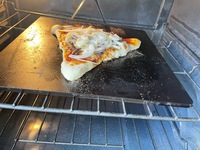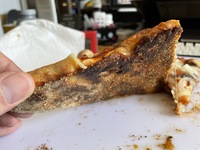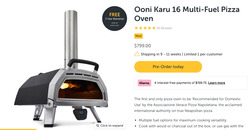 |
| Angelika/Mike Schilli |
|
|
|
Michael When it comes to pizza, like many of you, I grew up with the average offerings in Germany, which aren't bad. But when I was a young lad and visited New York City for the first time, driven by hunger in the middle of the night, I left the youth hostel and walked across the street to a branch of the chain "Roy's Pizza" to get a slice. I almost fainted because this piece of pizza was orders of magnitude better than anything I had ever devoured in Germany under the name "pizza".
In America, pizza naturally tastes much better than in its country of origin, Italy, where the dish is mainly fed to clueless budget tourists who can't afford meals in the more upscale restaurants with real Italian food. In America, and actually mainly in New York City, pizza ranks among the dishes where the locals have zero tolerance for sloppy cooking skills. The "New York Style" is known throughout the country for its thin, crispy crust, and when it comes to ingredients, apart from tomato sauce, mozzarella cheese, and maybe anchovies, nothing else is really allowed. Asking for anything different would be about as embarrassing as ordering red wine with ice in a street café in Paris.
In San Francisco's pizzerias, I often find the pizza to be too doughy. I don't even want to mention the "Chicago-Style," which for the worldly man is not pizza at all, but rather a quiche, though opinions on this differ. And another thing: frozen pizza is an imposition, and anyone who heats one up at home should consider whether they haven't already turned into a one-way street in life, at the end of which stands a sign reading "Bankruptcy." The soggy pizza from delivery services is no substitute either, and for those who want to eat pizza at home, the only real option is to knead the dough yourself, stretch it out, add canned pizza sauce (Don Peppino is quite good) and grated cheese (a bit of Parmesan first, then a heap of Mozzarella), and somehow bake it using your home oven.
To effectively transfer the heat from the home oven, which usually maxes out at 550°F (290°C), to the pizza, many people buy a so-called pizza stone. This is a ceramic slab that you heat in the oven for a good half hour before launching the flat pizza onto it using a large paddle. This method works quite well, but the stone does not transfer heat to the pizza as effectively as a piece of steel that is equally hot. Why? The thermal conductivity of steel is higher than that of ceramic. Consequently, an equally hot piece of steel transfers more heat to the pizza dough lying on it, causing the bottom to slightly burn. This results in dark brown spots on the underside, known as "leoparding," which gives the dough its distinctive pizza flavor. The problem, of course, is that a one-centimeter thick piece of steel in the size of 40cm x 40cm weighs about as much as a small car and starts to rust within seconds if left standing wet. Like a cast iron pan, you should not use dish soap to clean it; instead, you should occasionally apply a layer of cooking oil to prevent the dough from sticking during the next pizza baking session.
Admittedly, this dough doesn't taste like it was baked in a 500-degree wood-fired oven of a pizzeria, but for a home oven, the result is acceptable -— certainly much better than with conventional methods. If you still want to compete with a pizzeria at home, you can buy a portable gas or wood oven from the company "Ooni." Reliable sources have assured me that the pizzas from these small but hot devices actually have pizzeria quality. Unfortunately, we don't have the space, and such an oven has to be kept outside because of the exhaust fumes!
Greetings from San Francisco:
Angelika and Michael













